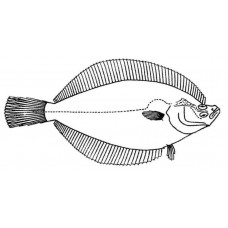Latin name
Limanda proboscidea
Other names
Limanda proboscidea
Identification
The lateral line forms a high arch above the base of the pectoral fin. The pectoral appendages are long. Both jaws on the ocular side of the head have 6 or more teeth. The teeth on the jaws are conical, single-rowed, with no single cutting edge. There is no distinct, rough ridge behind the eyes. Gill lobes are short and thick. The snout almost does not protrude from the upper profile of the head. There are more than 80 scales on the lateral line. The head is slightly concave above the centre of the upper eye. The snout is elongated, its length is greater than the diameter of the eye.
Features of fish fins
The dorsal fin has 62-74 soft rays. The anal fin has 46-53 soft rays.
Fish colouring
The eye side of the body is greyish brown or greenish brown. There are no black thin stripes on the scales of the ocular side of the body. The blind side is lemon yellow.
Distribution
Its natural habitat is the temperate waters of the North Pacific Ocean, and its range extends from the Sea of Okhotsk and the Kuril Islands to the Bering Sea and the Arctic west coast of Canada.
Habitat
It is a bottom-dwelling fish that lives at depths of up to 160 metres (520 feet), although it is most commonly found between 10 and 125 metres (33 and 410 feet). It prefers temperate climates.
Size
Males grow to 40 centimetres (16 inches) in length, although the normal length is about 17.5 centimetres (6.9 inches).
Behavior
They are found in desalinated areas near river mouths. During the winter months they move to deeper waters.
Food and feeding habits
The diet consists mainly of zoobenthos organisms, including polychaetes, bivalves, amphipods and other benthic crustaceans.
Reproduction
Males mature for the first time at an age of 3 years with a body length of 14-18 cm, depending on the habitat. Females mature at the age of 4 years with a body length of 14-22 cm. Spawning is batch spawning from late June to early September with a peak in July-August at bottom temperatures of 0.8 to 12°C. Fecundity ranges from 83,000 to 840,000 eggs. Eggs are pelagic, spherical in shape.
Fishing
It is the subject of commercial fishing.
Relationship with a person
Edible fish. It is sold fresh, frozen and used in the production of canned food.
| Classification | |
| Phylum | Chordata |
| Class | Actinopterygii |
| Squad | Pleuronectiformes |
| Family | Pleuronectidae |
| Genus | Limanda |
| Species | L. proboscidea |
| Features | |
| Conservation status | Least Concern |
| Habitat | Bottom |
| Life span, years | No information |
| Maximum body weight, kg | No information |
| Maximum length, cm | 40 |
| Sailing speed, m/s | No information |
| Threat to people | Edible |
| Way of eating | Bentophage |
Longhead dab
Tags: longhead dab

